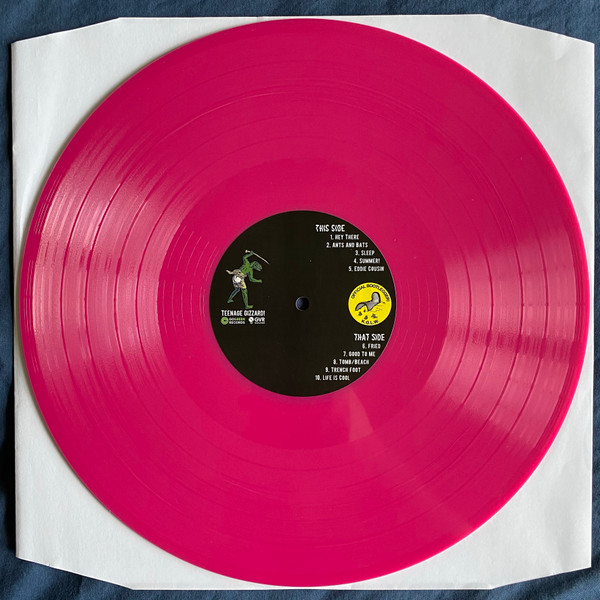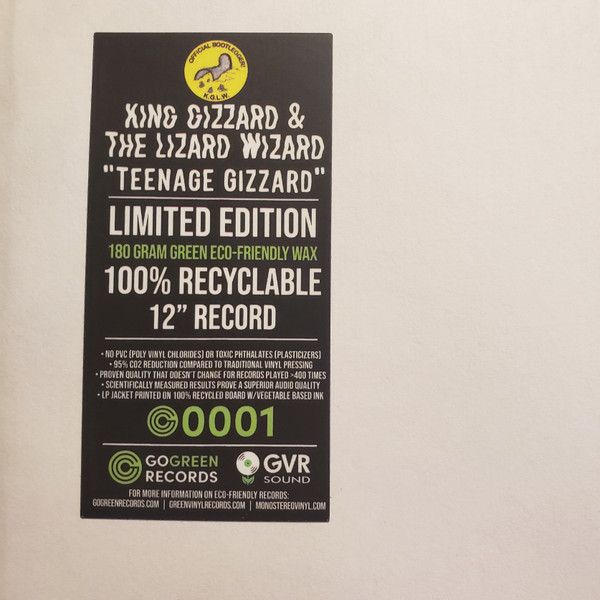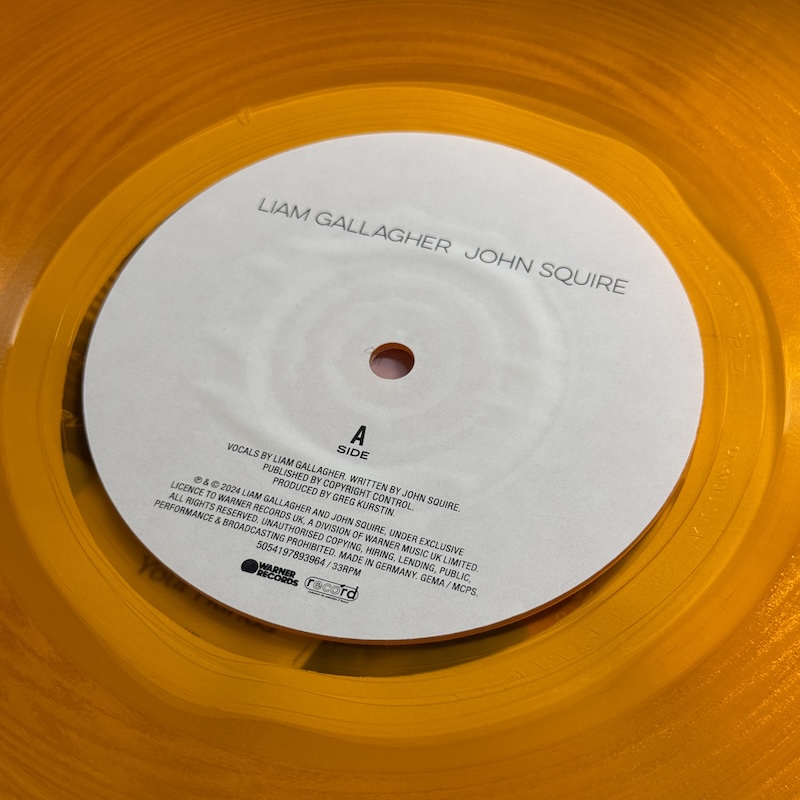第1回、第2回、第3回、第4回 に続き、戦後のレコード製造工程や原材料の歴史、特に 射出成形 と スチレン盤 について改めて調べてみた、そんな記録です。
Following on from the first, second, third and fourth parts, this is a record of a renewed look into the history of postwar record manufacturing processes and raw materials, particularly injection molding and styrene records.
5回目となる今回は、1964年の Burt Bacharach = Hal David 両氏へのインタビュー記事に登場する射出成形スチレンシングル盤への不満という面白いエピソードのほか、英国の射出成形ヴァイナル盤研究開発を捉えた興味深い動画の紹介、同じく射出成形ヴァイナル盤製造を1970年代に行っていた日本コロムビアの学術論文、最後に21世紀になって登場した「エコフレンドリーな」射出成形PET盤について、それぞれみていきます。
This time, the fifth part, we’ll be looking at an amusing anecdote about dissatisfaction with injection-molded styrene singles, which appears in a 1964 interview with Burt Bacharach and Hal David; an intriguing video documenting the research and development of injection-molded vinyl records in the UK; an academic paper from Nippon Columbia, which also manufactured injection-molded vinyl records in the 1970s; and finally, the “eco-friendly” injection-molded PET records that have emerged in the 21st century.
レコード業界における射出成形による製造法の役割が、長期的なコスト削減および生産効率向上、という目的から、持続可能なレコード文化存続へ、とシフトするさまを現在進行形でみているんだなぁ、という思いを強くした学びでした。
This study reinforced my belief that we are currently witnessing an ongoing shift in the role of injection molding in the record industry, from long-term cost reduction and improved production efficiency to the preservation of a sustainable record culture.
Contents / 目次
- Burt Bacharach、スチレン盤への不満を語る / Interview with Burt Bacharach (1964, The Billboard)
- 「原材料不足が45回転盤の品質を押し下げる」 “Raw Materials Shortages” (1973, The Billboard)
- 1960年代: British Geon Ltd.、射出成形ヴァイナル盤テスト製造 / Injection-molded vinyl records
- 1971: 日本コロムビア、射出成形ヴァイナル盤に関する研究論文を発表 / Nippon Columbia’s research paper on injection-molded vinyl records
- 2016: Symcon 社、環境に配慮した射出成形LP製造技術を公開 / Symcon unveils injection-molded LP technology
- 2023: 独 Sonopress 社、射出成形PET盤「EcoRecord」の生産開始 / Sonopress debuts EcoRecord
- 2022〜: EU、PVC を「有害な化学物質リスト」に追加、段階的禁止へ / EU adds PVC to “list of hazardous chemicals”
- 所感 / Observations
Burt Bacharach、スチレン盤への不満を語る / Interview with Burt Bacharach (1964, The Billboard)
レコード製造工程とは直接関係ない記事で、著名人によるスチレン盤嫌悪が表明されている、非常に興味深い記事を発見しました。
I came across a very interesting article that has nothing to do with the record manufacturing process, but in which a celebrity expressed his dislike of styrene records.
The Billboard 1964年4月8日号 に、当時次々大ヒット曲を連発していた作詞作曲チーム、Hal David と Burt Bacharach に関する連載インタビュー記事が掲載されました。
The Apr. 8, 1964 issue of The Billboard featured a series of interviews about Hal David and Burt Bacharach, the famous songwriting team who were producing one hit after another at the time .
この中に、射出成形スチレン盤に対する不満ともいうべきバカラック氏のコメントが掲載されているのです。
This includes comments from Bacharach that seem to express his dissatisfaction with injection-molded styrene records.
Burt Bacharach continued, “Unfortunately there has to be a gradual diminishing of sound quality of the ‘date’ — down to a monaural mix, then the ‘final catastrophe’ when it goes into and and out of a pressing plant.”
バート・バカラック氏はこう続けた。「残念ながら、『レコーディングセッション』の時の音は、最終的にモノーラルミックスとなるまでに経るさまざまな工程で徐々に低下してしまうものだ。そしてプレス工場に送られ、そしてプレスされて出てくる、この最後の工程を経た結果『最悪の大惨事』となるんだ。
“Economics are involved in all record companies’ choices of materials in pressing. Pure vinyl should be used on the test pressing for the DJ copies. We feel that anything else is false economy.”
「どのレコード会社においても、プレスする際の素材の選定には経営判断が絡んでいる。DJ用のテストプレスにはピュアヴァイナルを使うべきであり、それ以外は経済の理屈からしても間違っている、と我々は感じている。」
“We find that there is a difference in various songs and ‘date’ we do, varying from time to time on whether a compression or injection pressing method was used. Thus, we always get pressings from at least two plants on every ‘date’, and we choose the record closest to the original tape sound. Not many songwriters and producers go out inspecting pressing plants.”
「圧縮成形盤か射出成形盤かによって、我々が関わった様々な『セッション』で生み出した曲の音に違いがあることが分かる。だから私たちは常に、それぞれの『セッション』ごとに、少なくとも2箇所以上のプレス工場からテストプレスを入手し、オリジナルテープの音に最も近い盤を選んでいる。我々がやっているようにプレス工場を視察に行く、そんな作詞作曲家やプロデューサはあまり多くない。」
Bacharach said: “When I hear the record on the radio for the first time I ascertain right then and there whether it really has it for a hit. But, hearing it on the air will never have the excitement that I get while making the record in the studio due to limited ability of the radio to reproduce the sound that I had put on tape.”
バカラック氏はこうも述べた。「(我々が作ったレコードを)ラジオで初めて聴く時に、その曲が本当にヒットするかどうかをその場で判断する。しかし、スタジオで録音しレコード制作している時のような興奮は、ラジオ放送からは決して得られない。スタジオで私がテープに閉じ込めたあの音をラジオで再現するには限界があるからだ。」
“Inside R&B: David & Bacharach Profile: Part 1”, The Billboard, April 8, 1964, p.14このバカラック氏のコメントが当時の典型的なものか、は議論の余地があるかもしれませんが、こうやって音楽関係者からも当時の(特に45回転盤の)レコードの質のばらつきについて、否定的な意見が出ていたことを示す、貴重な資料であるといえるでしょう。
While it may be debatable whether Bacharach’s comments were typical of the time, they are a valuable document that shows that even those in the music industry were expressing negative opinions about the inconsistency in the quality of records (especially 45 rpm) at the time.
「原材料不足が45回転盤の品質を押し下げる」 “Raw Materials Shortages” (1973, The Billboard)
1970年代の The Billboard 誌で、射出成形、またはスチレンというキーワードが久しぶりに登場しました。1973年、すなわち オイルショック と関係していたかは不明ですが、再び深刻なレコードの原材料不足が懸念されていました。
The keywords “injection molding” and/or “styrene” first appeared in The Billboard magazine in the 1970s. In 1973, there were concerns about a serious shortage of raw materials for records, although it is unclear whether this was related to the oil crisis.
1973年10月6日号 では、1面トップ記事として「Industry Tackles Plastics Shortage」が掲載され、米国各レーベルがポリ塩化ビニルやポリスチレンの確保に奔走している様子が捉えられています。
The Oct. 6, 1973 issue featured a front-page headline headline titled “Industry Tackles Plastics Shortage”, depicting American labels scrambling to secure supplies of polyvinyl chloride and polystyrene.
さらには長編解説記事「Shortages of Materials: This Year’s Pain In The Neck」および「Accesory Firms Keep Sharp Eye Out For Raw Materials Shortages」も掲載されており、テープ業界、紙業界、コンピュータ用ストレージ業界、各種アクセサリ業界など、あらゆる業界でプラスチック原材料や化学製品不足への懸念が渦巻いていたことを伝えています。
The issue also includes lengthy commentary articles, “Shortages of Materials: This Year’s Pain In The Neck” and “Accessory Firms Keep Sharp Eye Out For Raw Materials Shortages”, which report on concerns about shortages of plastic raw materials and chemical products in a wide range of industries, including tape, paper, computer storage, and various accessories.
続く 1973年10月13日号 には、続編として「Shortages Pinch 45 Quality Push」という記事が掲載されています。
The following issue, Oct. 13, 1973, featured a follow-up article titled “Shortages Pinch 45 Quality Push”.
記事執筆者は Earl Paige 氏、1966年から1993年まで Billboard 記者を務めた方です。
The article was written by Earl Paige, who was a reporter for Billboard from 1966 to 1993.
CHICAGO — Jukebox programmers and home phonograph manufacturers involved in the multifaceted efforts to improve the quality of 45’s are watching carefully the shortage of raw materials (Billboard, Oct 6). While attention is directed at the short supply of benzine, the main compound from which polyvinyl chloride (PVC) is made and hence LP’s, experts point to an even more critical shortage of polystyrene used for singles. A chief worry of jukebox people is that more and more singles pressing will be farmed out as a result of the crunch on LP’s, and such farmouts have resulted in poorer quality 45’s.
シカゴ発 — 45回転盤の品質向上のため多方面にわたる取り組みを行っているジュークボックスプログラマや家庭用レコード業者は、原材料の不足を注意深く見守っている(本誌10月6日号)。LP の原材料であるポリ塩化ビニル (PVC) の原料となるベンジンの供給不足が注目されているが、専門家は、シングル盤に使われるポリスチレンの不足がより深刻である、と指摘している。ジュークボックス関係者が最も懸念しているのは、LP盤の逼迫の結果、45回転盤のプレスがますます外部に委託され、結果として45回転盤の品質が劣化することである。
Bryce Johnson, industrial manager of compounds. Tenneco Chemicals, Piscataway, NJ., said, polystyrene “is drying up faster than PVC. This would make sense because it is low-end product and would be bought up faster.” A NJ. pressing plant manager said he believes some problems with 45’s stems from injection molding with polystyrene. “1 don’t even believe they should use styrene, but I suppose it’s a cost factor again.”
ニュージャージー州ピスカタウェイの Tenneco Chemical社生産マネージャの Bryce Johnson 氏は、ポリスチレンは「PVC より先に枯渇している。ポリスチレンは低価格製品であり、早く買い占められるため、これは当然のことだ」と語った。ニュージャージー州のあるプレス向上のマネージャは、45回転盤の問題の一部は、ポリスチレンの射出成形に起因すると考えている、と述べた。「私はスチレンを使うべきではないと思うが、これもまたコスト要因だと思う。」
“Shortages Pinch 45 Quality Push”, The Billboard, October 13, 1973, p.23米国において射出成形スチレン45回転盤が長らく流通していた理由は、やはりコスト要因が最も大きかったのであろう、それを如実に表す記事であると言えます。
This article clearly shows that the biggest reason why injection-molded styrene 45 rpm records remained in circulation in the United States for so long was probably cost.
しかし、ジュークボックス業界からもあまり歓迎されていなかったように読める、そんなスチレン盤ですが、レーベル側の経営判断により、1980〜90年代にアナログレコードがフェードアウトするまで、引き続き米国では盛んにリリースされていたわけですね。
However, it seems that styrene records were not very well received in the jukebox industry either. However, due to business decisions by the labels, they continued to be released frequently in the US until the fade-out of analog records in the 1980s and 1990s.
あと、個人的に気になるのは、「45回転盤のプレスがますます外部に委託され」という箇所で、自社プレスではまかないきれない分を外部委託する、そしてその分はコストを圧縮しようとする、すなわち射出成形スチレン盤になる確率が高くなる、ということだったのかもしれませんね。
Also, what bothers me personally is the part that says, “more and more singles pressing will be farmed out”, which may mean that they are outsourcing the parts that they cannot handle through their own pressings, and that they are trying to cut costs by using that amount, which means that there is a higher chance that injection-molded styrene records will be used.
1960年代: British Geon Ltd.、射出成形ヴァイナル盤テスト製造 / Injection-molded vinyl records
話は一気に変わります。
Here the story changes abruptly.
英国の British Geon Ltd. 社が、射出成形盤に適したポリ塩化ビニルの組成を1960年代に調査研究した結果をまとめ、サンプル生産した7インチ45回転盤が付属したドキュメントが、YouTube で紹介されているのを見つけました。
I found a document on YouTube that summarized the results of research conducted in the 1960s by British Geon Ltd. on the composition of polyvinyl chloride suitable for injection molding discs, and included a sample 7-inch 45 rpm disc they produced.
ただただ圧巻の貴重な資料なので、ご覧ください。
This is simply an impressive and valuable resource, so please take a look.
現時点では、英国でのプレス工場とプレス技術、当時の英国レコード業界や各レーベルの思惑、などを探る資料をほとんど見つけられていないため、英国での廉価盤の歴史やそこで使われた原材料について情報を得ることができずにいます。そしてなぜ、英国(や欧州)では、ポリスチレンが使われなかったのか、も非常に気になるところです。
At present, I have been unable to find any information about the history of budget records in the UK or the raw materials used, as I have been unable to find any information about the UK pressing plants and pressing techniques, or the intentions of the UK record industry and labels at the time. I am also very curious as to why polystyrene was not used in the UK (or Europe).
この辺りは、今後の調査課題としたいと思っています。
This is an area I would like to explore in the future.
そのため、あくまで推測ですが、この British Geon Ltd. 社の取り組みが、1970年代に英国で射出成形ヴァイナル45回転盤が生産されるようになった、そのさきがけだったのかもしれません。
Therefore, although it is only speculation, it is possible that the efforts of British Geon Ltd. were the precursors to the production of injection-molded vinyl 45s in the UK in the 1970s.
1971: 日本コロムビア、射出成形ヴァイナル盤に関する研究論文を発表 / Nippon Columbia’s research paper on injection-molded vinyl records
1971年、学会論文誌「高分子化學」に「射出成形レコードの成形性」という論文が掲載されました。執筆者は、日本コロムビア(株)研究開発本部の4名です。
In 1971, a paper titled “Moldability of Injection-Molded Records” was published in the academic journal “Polymer Chemistry”. The authors were four people from the Research and Development Headquarters of Nippon Columbia Co., Ltd.
この論文は、射出成形盤製造に適した材料を調べるため、ポリ塩化ビニル、ポリメタクリル酸メチル、特殊配合ポリスチレンの3種について、流動性、成形加工性を測定した上で、レコードの成形性、およびできあがったレコードのS/N比や混変調歪率に対する金型温度と型締力の影響について調査したものです。
In order to find materials suitable for injection-molded disc manufacturing, this paper measured the fluidity and moldability of three types of polyvinyl chloride, polymethyl methacrylate, and specially formulated polystyrene, and then investigated the effects of mold temperature and clamping force on the moldability of records, as well as the signal-to-noise ratio and intermodulation distortion of the finished records.
結果、ポリ塩化ビニルは成形性が低いため型締力は100トン以上を必要とするが、S/N比や耐摩耗性などの音響特性が最も優れていることが分かった、と結論づけています。
As a result, they concluded that polyvinyl chloride has low moldability and requires a clamping force of more than 100 tons, but that it has the best acoustic properties, such as S/N ratio and abrasion resistance.
そして、日本コロムビアは1970年代〜1980年代にかけて、45回転シングルとして射出成形ヴァイナル盤を製造・販売することとなります。
Nippon Columbia then began manufacturing and selling injection-molded vinyl 45 rpm singles throughout the 1970s and 1980s.
おそらくは、レコード製造に限らず一般的なプラスチック加工分野において、射出成形そのものの技術レベルがあがったことにより、かつては難しいとされていたポリ塩化ビニルの射出成形技術を用いたレコードが実用レベルになってきたこと、そして出来上がったレコードも品質的に問題ないレベルと判断された、などの要因があるのではないか、そのように推測できます。
One can speculate that one of the reasons for this is that the level of technology for injection molding itself has improved, not only in record manufacturing but in the general plastic processing field, and records made using polyvinyl chloride injection molding technology, which was once considered difficult to make, has become practical, and the finished records are now deemed to be of acceptable quality.
2016: Symcon 社、環境に配慮した射出成形LP製造技術を公開 / Symcon unveils injection-molded LP technology
1980年代後半、主たる音楽メディアとしての座をCDに明け渡して完全に下火となったアナログレコード製造は、2000年代中頃に底を打ちました。音楽の主要メディアも、CD から MP3 などのディジタルファイルへ、そしてストリーミングや動画共有サイトへと変化していきました。
In the late 1980s, vinyl record production completely declined after being replaced by CDs as the primary music medium, hitting rock bottom in the mid-2000s. The primary music medium also shifted from CDs to digital files such as MP3s, and then to streaming services and video sharing sites.
多くのレコード製造(プレス)工場が操業時間の短縮または休業・廃業となり、レコード製造のノウハウも一旦止まることとなりました。また、カッティング技術についても跡を継ぐ人が少なくなり、レコードというメディア・文化にとって最も辛い時期だったことでしょう。
Many record manufacturing (pressing) factories reduced their operating hours or closed down or went out of business, and the know-how of record manufacturing came to a halt. Furthermore, there were fewer people to take on the cutting skills, making this the most difficult period for the record medium and culture.
ところがレコードはその後不思議なことに、かつてのような大量生産品としてではなく、好事家向けのニッチなメディアとして、徐々に復権を果たしてきました。現在では多くの新譜がLPフォーマットでも販売され、また過去の名盤のLP復刻も盛んです。
However, strangely enough, records have since gradually made a comeback, not as a mass-produced product as they once were, but as a niche medium for connoisseurs. Many new releases are now sold in LP format, and LP reissues of classic albums from the past are also popular.
そんな中、別の文脈から、再び射出成形に脚光があたったのが、2016年11月 でした。
Meanwhile, in November 2016, injection molding was once again in the spotlight, albeit from a different perspective.
1995年設立、オランダの Symcon 社は、CD や DVD など光学ディスク製造用の原材料や製造パーツの会社ですが、レコード復権に伴い、EU からの助成金を受け研究開発したのが、環境に優しく製造時のエネルギー効率をあげた、射出成形LPレコード製造方法です。
Founded in 1995, Symcon, a Dutch company, supplies raw materials and manufacturing parts for the production of optical discs such as CDs and DVDs. With the resurgence of vinyl records, the company received a grant from the EU to research and develop an injection-molded LP record manufacturing method that is environmentally friendly and increases energy efficiency during production.
最初に報じたのは Discogs が Symcon 社に行ったインタビュー記事「Injection Moulded Records – Vinyl Of The Future?」だったようです。
The first report seems to have been an interview conducted by Discogs with Symcon titled “Injection Moulded Records – Vinyl Of The Future?”.
その直後、さまざまなメディアでも話題となりました。
Shortly after, it became a hot topic in various media.
当時の Symcon 社の研究開発目的は、以下のように要約されます。
- 圧縮成形のように蒸気を使わないため、レコード製造時のエネルギー効率を大幅に改善できる
- スタンパーへの負担が圧縮成形より低くなるため、スタンパーの耐用回数を伸ばせる
- 1枚製造あたりの時間も短縮でき、製造効率をあげられる余地がある
- プレス後にトリミングする必要がないため、原材料の無駄を省ける
- 機器のメンテナンス性の向上により、ターンアラウンドタイム(実際にレコードが店舗に並ぶまでの期間)を短縮可能
- 従来の圧縮成形ヴァイナル盤よりも再生品質を向上させられる可能性がある
Symcon’s research and development objectives at the time can be summarized as follows:
- Unlike compression molding, this method does not use steam, which significantly improves energy efficiency during record manufacturing
- The burden on the stamper is lower than with compression molding, so the stamper can be used for a longer period of time.
- The time required to produce one piece can also be reduced, leaving room for improvement in manufacturing efficiency.
- No trimming required after pressing, reducing raw material waste
- Improved equipment maintainability can shorten turnaround time (the time it takes for records to actually appear in stores)
- Potential for improved playback quality over conventional compression-molded vinyl records
この2016年時点では、新製造方式に適した、品質と音質に貢献する原材料がまだ確定しておらず、カラーヴァイナルにするための方法も調査中、という段階でした。
As of 2016, the raw materials that would contribute to the quality and sound quality of the new manufacturing method had not yet been determined, and methods for producing colored vinyl were still being investigated.
2021: Green Vinyl Records、世界初の射出成形PET盤を生産 / World’s First Injection-molded PET records
その Symcon 社が、2021年9月21日に子会社として Green Vinyl Records というレコードプレス工場を設立、これはオランダの8社による合同プロジェクトでした。社名からわかるように、環境に配慮した新時代のレコードを目指している、ということなのでしょう。
On September 21, 2021, Symcon established a subsidiary record pressing plant called Green Vinyl Records, a joint project between eight Dutch companies. As the company name suggests, the aim was to create environmentally friendly records for a new era.
また、Green Vinyl Records 自体が GVR Sound レーベルを立ち上げました。さらに、このレーベルを筆頭に、2021年暮れに Green Vinyl Records 工場でプレスされた LP の出荷が次々に始まりました。
Green Vinyl Records itself has also launched the GVR Sound label, which began shipping LPs pressed at the Green Vinyl Records plant in late 2021.
1950年代中頃にお目見えした射出成形LP盤から70年近くたって、ついに、新技術・新時代の射出成形LPが登場したのです。
Nearly 70 years have passed since the injection-molded LP record first appeared in the mid-1950s, and now a new technology and new era of injection-molded LPs has finally arrived.
Discogs 上では、2021年リリース、Green Vinyl Plastic プレスの LP が、11タイトル掲載されています。
Discogs lists 211 LP titles released in 2021 and pressed on Green Vinyl Plastic.

source: Discogs entry.
Teenage Gizzard / King Gizzard And The Lizard Wizard
King Gizzard And The Lizard Wizard (Go Green Records / GVR Sound 0001, 2021)
Green Vinyl Records プレス工場で製造された恐らく最初のタイトル、オーストラリアのサイケロックバンドのアルバム
これはピンク盤だが、グリーン盤も同時リリース
これらの LP には、Green Vinyl Records プレスのレコードの特徴が以下のように記されたステッカーが貼られています。
- 限定生産 180g グリーン エコフレンドリー素材 100%リサイクル可能な12インチレコード
- PVC (ポリ塩化ビニル) 、フタル酸エステル(可塑剤)を一切含まない素材
- 従来のヴァイナル盤プレスと比べてCO2排出量を95%削減
- 400回以上再生しても変わらない実証済の品質
- 科学的な測定結果が優れたオーディオ品質を証明
- 100%リサイクル紙に植物性インクで印刷したLPジャケット
These LPs have a sticker on them that lists the vinyl characteristics of the Green Vinyl Records pressing as follows:
- LIMITED EDITION 180 GRAM GREEN ECO-FRIENDLY WAX, 100% RECYCLABLE 12″ RECORD
- No PVC (Poly Vinyl Chlorides) or Toxic Phthalates (Plasticizers)
- 95% CO2 Reduction Compared To Traditional Vinyl Pressing
- Proven Quality That Doesn’t Change For Records Played > 400 Times
- Scientifically Measured Results Prove A Superior Audio Quality
- LP Jacket Printed On 100% Recycled Board w/ Vegetable Based Ink

source: Discogs entry.
Go Green Records 0001 (グリーン) のジャケ全体を収めるアウタースリーブに加貼されたステッカー
そして、Green Vinyl Records がポリ塩化ビニルの代わりに使用したのが、ポリエチレンテレフタート、すなわち PET であることが明らかとなりました。
It was later revealed that Green Vinyl Records had replaced polyvinyl chloride with polyethylene terephthalate, or PET.
Green Vinyl Records が使用している、オランダの産業用混合機専門メーカ Movacolor B.V. のサイトでは、なぜ Green Vinyl Records が PET を最終的に選択したか、について紹介するパラグラフがあります。
On the website of Movacolor B.V., a Dutch manufacturer of industrial mixers used by Green Vinyl Records, there is a paragraph explaining why Green Vinyl Records ultimately chose PET.
かつての射出成形スチレン盤の時のような「コストをかけず廉価に大量生産するため」が動機ではなく、やはり、時代を反映した「環境に配慮した持続可能な取り組みで、レコードという文化も持続可能にする」という動機であることがみてとれます。
It appears that the motivation is not “to mass-produce at low cost and at low cost”, as was the case with the old injection-molded styrene records, but rather “to make the culture of records sustainable through an environmentally friendly and sustainable initiative”, which reflects the times.
Diving deeper into the traditional way of LP production, Harm also found that PVC has several limitations regarding sustainability and circularity.
LPの伝統的な生産方法をさらに詳しく調べた結果、(Symcon 社オーナーの)Harm Theunisse 氏が発見したのは、PVC(ポリ塩化ビニル)には持続可能性と循環性においていくつか制限があることであった。
Although PVC is a versatile material, it is associated with negative environmental effects due to the presence of toxic substances. Moreover, PVC is not highly conducive to recycling. Therefore, in an effort to address these concerns, Harm decided to find a more environmentally friendly alternative to PVC and eventually settled on virgin and recycled PET.
PVCは多用途の素材であるが、有害物質が含まれているため、環境に悪影響を及ぼす。さらに PVC はリサイクルにはあまり適していない。そのため、これらの懸念に対応すべく、PVC よりも環境に優しい代替品を探すことを決定し、最終的にバージン(未使用)PET とリサイクル PET に落ち着いた。
PET, unlike PVC, offers certain advantages in terms of environmental impact and recyclability. PET is easier to handle and has a higher recycling rate. It is considered more environmentally friendly due to its recyclability and the availability of recycling infrastructure for PET products. By opting for virgin and recycled PET, Harm aims to reduce the environmental footprint associated with the production and disposal of LP records.
PET は PVC と異なり、環境への影響とリサイクル性の点で一定の利点がある。PET は取り扱いが容易であり、リサイクル率も高くなっている。このリサイクル性の高さ、そして PET 製品用のリサイクルインフラが利用できることから、(従来の PVC レコードに対して)より環境にやさしいと考えられている。Harm 氏は、バージン PET とリサイクル PET を選択することで、LP レコードの製造と廃棄に伴う環境への影響を削減することを目指している。
“A Sustainable Solution in the Vinyl Industry”, MOVACOLORそして、原材料である PET をさまざまな色に均一に着色する際の問題を解決するために Movacolor 社と協力し、カスタムのプラスチック着色添加剤投入装置を開発し、カラーPETレコードの実用化に成功したとのことです。
To solve the problem of uniformly coloring the raw material PET in various colors, the company collaborated with Movacolor to develop a custom plastic color additive injection device, which successfully commercialized color PET records.
2023: 独 Sonopress 社、射出成形PET盤「EcoRecord」の生産開始 / Sonopress debuts EcoRecord
その2年後、今度は1957年創業のドイツのプレス会社で 1992年からは CD / DVD プレス会社として稼働していた Sonopress 社が2023年にレコードプレス事業再開を発表しました。エコフレンドリーを謳った「EcoRecord」ブランドのもと、やはり射出成形PET盤の製造を開始しました。
Two years later, Sonopress, a German pressing company founded in 1957 that had been operating as a CD/DVD pressing company since 1992, announced that it would resume record pressing business in 2023. Under the eco-friendly “EcoRecord” brand, they have also begun manufacturing injection-molded PET records.
世界初の EcoRecord として選ばれたのは、オアシスの Liam Gallagher、ストーンローゼズの John Squire の連名アルバム「Liam Gallagher and John Squire」のうち、Amazon 限定で販売されたドイツプレスのオレンジLP盤 (Warner Brecords 5054197893964, 2024) でした。
The world’s first EcoRecord was the German-pressed orange LP version (Warner Brecords 5054197893964, 2024) of the joint album “Liam Gallagher and John Squire” by Oasis’ Liam Gallagher and Stone Roses’ John Squire, which was sold exclusively on Amazon.

Liam Gallagher & John Squire (Warner Records 5054197893964, PET, Orange)
from my own collection
Sonopress でプレスされた射出成形PET盤「EcoRecord」の第1弾リリース
その後、2024年8月に、著名な評論家 Michael Fremer 氏が EcoRecord を取り上げた記事を掲載したことで、一気に知名度があがることとなります。
Then, in August 2024, renowned critic Michael Fremer published an article about EcoRecord, which caused it to become widely known.
Abbey Road Studios の錚々たるエンジニア、Lucy Launder、Geoff Pesche、そして Miles Showell の3氏が、Sonopress 社の工場を訪問した、というプレス記事も話題になりました。
There were also some hot topics in the press about a visit to the Sonopress factory by three of Abbey Road Studios’ top engineers, Lucy Launder, Geoff Pesche, and Miles Showell.
2022〜: EU、PVC を「有害な化学物質リスト」に追加、段階的禁止へ / EU adds PVC to “list of hazardous chemicals”
Green Vinyl Records や EcoRecord のこういった取り組みの背景には、EU で PVC 禁止の動きが出ていることが大きな要因として考えられます。
A major factor behind these efforts by Green Vinyl Records and EcoRecord is thought to be the movement to ban PVC in the EU.
2022年1月、EU が「The use of PVC (poly vinyl chloride) in the context of a non-toxic environment」(非毒性環境におけるポリ塩化ビニルの使用)というレポートを公開しました。
In January 2022, the EU published a report titled “The use of PVC (poly vinyl chloride) in the context of a non-toxic environment”.
ポリ塩化ビニル (PVC) およびそこで使用されている各種添加剤が、環境および人体に悪影響を及ぼす、として、EU での流通を禁止すべきという流れが始まりました。そして2022年4月には「Restrictions Roadmap for chemical sustainability」(化学物質の持続可能性に関する規制ロードマップ)を発表、そのなかに PVC および添加剤が含まれました。
There is a movement to ban polyvinyl chloride (PVC) and the various additives used in it from distribution in the EU due to their adverse effects on the environment and human health. In April 2022, the EU announced the “Restrictions Roadmap for chemical sustainability”, which included PVC and its additives.
そして「ポリ塩化ビニルを2030年までに段階的廃止すべき」という意見が、多くの NGO から出されています。
Also, many NGOs have expressed the opinion that polyvinyl chloride should be phased out by 2030.
2023年11月には、EHCA (欧州化学物質庁) が、PVC および添加剤の中から、環境および人体への有害性を持つ一部物質を特定した、とレポートを公開、規制措置が必要、としています。
In November 2023, the European Chemicals Agency (EHCA) published a report stating that it had identified some substances in PVC and additives that are harmful to the environment and human health, and that regulatory action is necessary.
これらの動きに呼応して、リサイクル率向上などにより PVC 開発の持続可能性を向上させるため、欧州の PVC 業界によって VinylPlus というプログラムを進めています。現在、2024年の進捗レポート が公開されています。
In response to these trends, the European PVC industry is running a program called VinylPlus to improve the sustainability of PVC development by increasing recycling rates, etc. A progress report for 2024 has now been published.
このような大きな動きがあるため、ヴァイナルに比べて環境負担の少ないとされ、同時にリサイクルのインフラがすでに存在する PET を使い、圧縮成形に比べて製造時のエネルギー効率や環境負荷に優れるとされる射出成形法でレコードを製造する、2010年代からそのような方法論と技術に改めて注目が集まった、と考えられます。
It is likely that, due to this major movement, renewed attention has been drawn since the 2010s to methodologies and technologies for producing records using PET, which is considered to have a lower environmental impact than vinyl and for which recycling infrastructure already exists, and injection molding, which is considered to be more energy efficient and environmentally friendly than compression molding.
今すぐなんらかの手を打たなければ、せっかく復権してきた「レコードという文化」が持続できない恐れがある、それが圧縮成形PET盤を生んだということなのでしょう。
If something wasn’t done immediately, there was a risk that the “record culture” that had been so hard-pressed to regain its popularity would not be able to continue, and this is probably why compression-molded PET records were born.
所感 / Observations
レコードの製造方法、および原材料の歴史変遷を学ぶ、が本シリーズ記事執筆の発端だったわけですが、ここにきてサステナビリティの話につながるとは、少々意外でした。
The idea for writing this series of articles was to learn about how records are made and the historical changes in raw materials, but it was a bit surprising to see it now lead to a discussion about sustainability.
「自分は新譜には興味がないから関係ない」「ヴィンテージ盤しか集めてないからどうでもいい」などという方もいらっしゃるかもしれません。しかし、新譜・旧譜を問わず、同じレコードというメディアとその歴史、メディアに刻まれた音楽を愛する者として、この問題を無視することはできない、少なくともこんな状況になっていることを知っておくべきである、ということは間違いないでしょう。
Some people may say, “It doesn’t concern me because I’m not interested in new releases”, or “I only collect vintage records, so it doesn’t matter to me”. However, as someone who loves the same medium, records, their history, and the music that is engraved in them, regardless of whether they are new or old, it is clear that we cannot ignore this issue, and that we should at least be aware that this is the situation we are in.
そういったことを再認識する、良い機会にはなりました。
For me, it really was a good opportunity to reaffirm these things.
さて、最終回となる次回は、今回の一連の記事のきっかけとなった、スチレン製廉価盤と思われる Mercury の3本線マーク入りレコードにまつわるあれこれについて書く予定です。
Well, in the next and final part of this article, I plan to write about various things related to the Mercury three-line record, which is thought to be a low-cost styrene discs and was the trigger for this series of articles.
» 続き / Sequel: “How Records Were/Are Manufactured (6)” »











